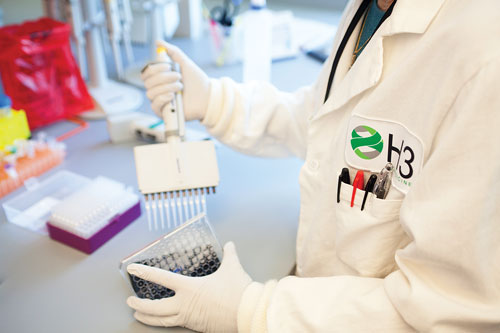November 15, 2015 (Vol. 35, No. 20)
Gail Dutton
H3 Biomedicine Maintains Multiple Platforms, Generates Diverse Anticancer Drug Candidates
H3 Biomedicine uses a combination of genomics, synthetic organic chemistry, and tumor biology to develop small molecules for cancer treatment. According to H3’s president and CEO, Markus Warmuth, M.D., “A small molecule approach creates opportunities to go after targets that antibodies can’t tackle.”
“There are only so many things that can be addressed with biologics,” he continues. “We pay attention to the best mode of action for each particular target, rather than focusing on a particular technological platform.”
Combining precision chemistry with a diversity focused library helps H3 increase its chemical space while keeping compounds to a manageable number. “We use numerous core scaffolds and a select number of compounds per core scaffold to build our library and address druggably challenged targets,” explains Dr. Warmuth. “Our diversity of approaches allows us to operate in a very flexible way that addresses the uniqueness of each situation.”
That includes working from the patient outward to identify biomarkers and compounds, rather than first finding promising compounds and then identifying likely patient populations. “Many companies are now embracing the power of this approach,” observes Dr. Warmuth.

At H3 Biomedicine, the development of small-molecule drugs against cancer is driven by cross-functional scientific teams with expertise in target validation, mechanistic enzymology, and advanced synthetic and biological chemistry. These teams leverage the biological significance of genetic changes in tumor development, growth, and maintenance, while also facilitating stratified patient enrollment into clinical trials based on specific genetic markers.
Upcoming Clinical Trials
The company plans to file two investigational new drug (IND) applications for two diverse projects in the first half of 2016. In one of the projects, H3 will study a molecule that tackles an important growth factor receptor. “The molecule,” details Dr. Warmuth, “will target the FGFR4 receptor for patients with liver cancer.”
The other project will focus on a compound that modulates splicing. Specifically, the compound targets a mutation in the gene for SF3B1, a component of the spliceosome, which is a large, dynamic protein complex that processes messenger RNA. The SF3B1 mutation is carried by a subset of patients with myelodysplastic syndrome.
Because H3 uses a drug discovery process that begins by defining genetic mutations or genes that were differentially expressed, the company can also use those markers in its clinical programs to identify patients that are likely to have the greatest benefit from a specific drug. “There have been multiple examples of drugs approved with their companion diagnostics in the past decade to identify the subpopulations of a disease for which a specific drug will be effective,” Dr. Warmuth notes.
“The availability of a companion diagnostic,” he adds, “enables drug development to progress significantly faster because we can focus on a hypotheses rather than identifying the right predictors of response for a compound empirically. Others using this approach have completed clinical trials within five years.”
Bioinformatics Investment
While many other companies apply a genomically informed approach to drug development in the clinic, H3 differentiates itself, says Dr. Warmuth, through its “heavy investment” in bioinformatics, an approach that it uses “from beginning to end.” H3’s data scientists and bio-IT specialists have developed a framework for omics data mining that identifies novel biologies and targets across various cancer subtypes.
Initially, H3 combed public genomic databases for interesting targets. “Today, we go beyond genomics and look at other datasets, such as transcriptomic and proteomic data,” informs Dr. Warmuth. “We bring that data in line with clinical annotations as well.”
The company also has invested in its own chemistries, which are based on diversity-oriented synthesis that yields diversity while limiting the quantity of compounds. “That gave us the support to tackle targets others would be hesitant to attempt,” asserts Dr. Warmuth. “As a drug developer, our approach is to understand patient populations and have tools to address their medical needs in the clinic.”
Targeted Relationships
When H3 was established by the Japanese pharmaceutical company Eisai in 2011, it was seen as a way to establish an entrepreneurial company within Eisai to drive precision drug development in oncology. “We are a wholly owned subsidiary, but we operate independently for research,” Dr. Warmuth insists. “We have access to Eisai’s resources and conduct clinical work with Eisai’s clinical unit.”
Eisai has provided H3 up to $200 million in funding. “This is a unique position for a young biotech company,” Dr. Warmuth says. “The idea behind this unconventionally high funding is to help H3 avoid what many companies have to undergo to raise funds to reach their next milestones.” It can be a real advantage to stay focused on science, suggests Dr. Warmuth, by avoiding fundraising-related interruptions.
In addition to maintaining its relationship with Eisai, H3 is interested in collaborating with other companies. “We like a lot of interaction,” says Dr. Warmuth, “and opportunities to work as equal partners.”
Those partners should have resources that complement H3’s internal expertise. For example, a collaboration announced in early 2015 combines Foundation Medicine’s extensive genomic knowledge base (built from a large number of patient samples) with H3’s target biology/validation expertise, to generate more precise biomarker selection.
Its 2012, collaboration with Selvita, one of the largest drug discovery companies in Eastern Europe, validated the druggability of many kinase targets for use in precision drug development. Since its inception, H3 also has engaged in multiyear agreements with the Beijing Genomics Institute to sequence genomic data from preclinical cancer models to identify and validate recurrent gene mutations. Other agreements included those with Compendia Bioscience, Horizon Discovery, and Sage Bionetworks.
“Our ultimate goal is to take our compounds through clinical proof of concept or pivotal clinical trials,” concludes Dr. Warmuth. “We bring strength in cancer biology, in computational biology, and in connecting genomic information to biological insights.”
As H3 matures, it will become more interested in partnering around preclinical and clinical development of targets and of assets.
H3 Biomedicine







